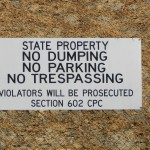
Caltrans has finished one study of the ground water beneath the three 132 Freeway right of way toxic waste sites. A report completed in June 2012 by Geocon for Caltrans concluded that no chemicals related to the toxic waste sites were found in ground water beneath the sites. Some who have heard the results of the one study have the misimpression that all studies on the waste sites are done, that the sites pose no health hazards to humans, and that freeway construction may now begin.
In reality, a lot more study is needed to assess the possible spread of contaminated material from the fifty year old toxic waste sites. When the studies are done, a decision will be made on what to do with the toxic waste on each site. Then, cleanup will begin. If any contamination exists in areas around the site, those areas would also need to be cleaned up. Only after all of these steps are taken will freeway construction be able to proceed.
Following is a brief summary of the results appearing in the 128 page Geocon report from June 2012. Next is an analysis of what the Geocon study did not examine. An employee of the California Department of Toxic Substances Control was interviewed for this report.
GEOCON STUDY RESULTS
According to the report, Geocon tested water from 8 wells that Caltrans previously dug within the three toxic waste sites. The wells are all within the 132 freeway right of way. None of the wells are on private property around the sites.
Geocon did not dig any new wells or test any of the water below a blue clay layer which separates the underground water closest to the surface from a major aquifer below it. The aquifer was not tested because upper level water was not found to be contaminated. Logically, if water closer to the surface is not contaminated, one would not expect the lower level water to be contaminated.
Geocon found traces of Manganese and Nitrates in the sampled well water. Manganese affects water taste but not human health. Nitrate was found at safe levels for human consumption but can pose a health risk in sufficient concentrations. The Manganese and Nitrate did not originate from the toxic waste sites. The Nitrate is believed to be residue from urban and agricultural fertilizer use.
After the Geocon report was completed, Cal Trans dug two new wells between the FMC toxic waste site and the 132 Freeway toxic waste sites to see whether FMC toxic waste has migrated towards the 132 freeway right of way. The results of the drilling will be issued in a future report.
FREE WELL TESTING OFFERED
Water quality has been tested by the Caltrans contractor only on publically owned land. Private land owners with a well within one mile of the 132 Freeway toxic waste sites may have their well water tested for free by contacting Steve Meeks of the California State Water Board at (916)464-4678. The Board wants to check wells on private property to see whether contaminants have migrated off of the toxic waste sites. So far, few private property owners have submitted a request for testing. Anyone who owns a well within a mile of the 132 right of way is urged to have the well tested for free.
STILL NOT BEEN TESTED
No soil samples have been taken and/or analyzed anywhere on or off public property in the 132 freeway right-of-way. No analysis has been done of soil adjacent to the toxic waste sites to see if there has been any surface migration of contaminated soil. A thorough plan to study soil that could be contaminated has not yet been devised. When a plan is created, it will be implemented by Caltrans with review by the California Department of Toxic Substance Control. Reports will be available for the public to read.
FUTURE DISPOSAL OF TOXIC MATERIAL
No decision has been made on the disposition of contaminated soil within the 132 right-of-way. The options are to haul the soil to an official toxic waste disposal site or to leave it where it is and encase it all in concrete. Over time, concrete cracks, deteriorates and leaks. However, the concrete alternative is less expensive in the short term. Do we want short term financial savings and risk having future long term problems? Or do we want to solve the problem once and for all and remove the toxic waste from our community? Cal Trans will be holding public meetings in the future. Please attend the meetings to express your opinion.
